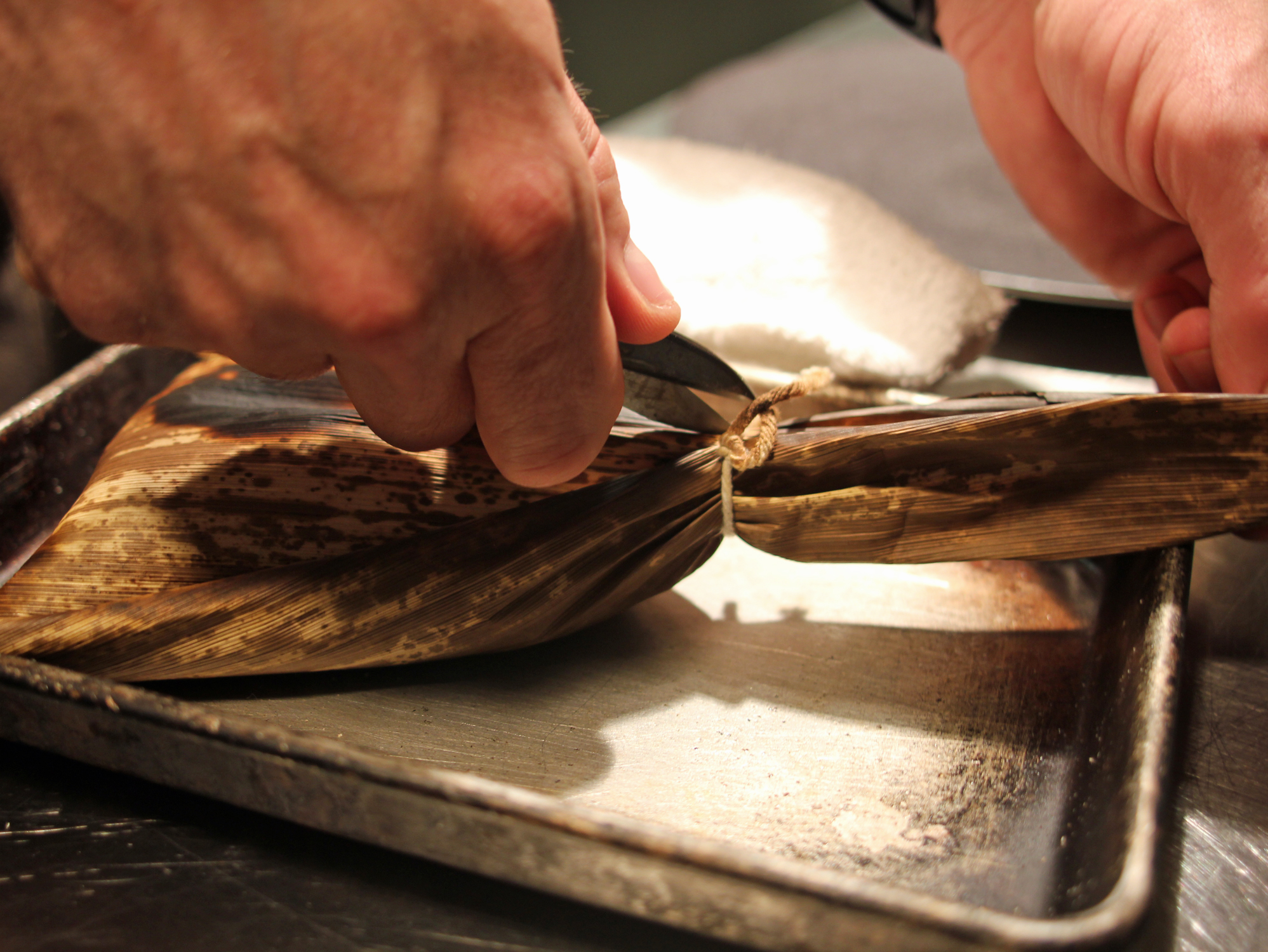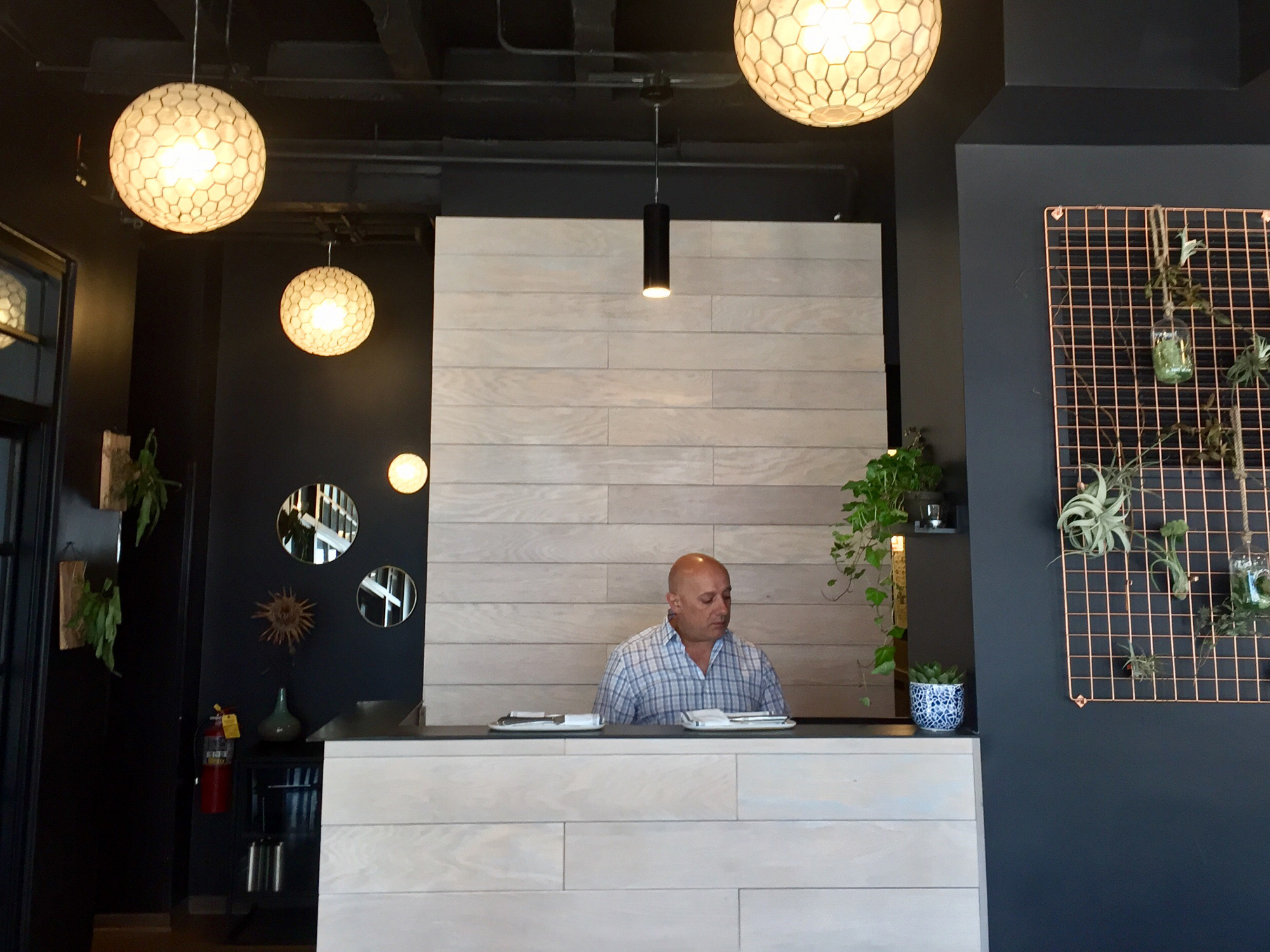ONE OF THE FASCINATING THINGS ABOUT covering the world of restaurants over time is popping back into people’s lives—and restaurant lives move quickly. Two years ago, Dan Salls was facing the end of his dream of making a food truck hub and taco joint in the West Loop, as he explained to me how the real estate dynamics of the area were pushing businesses like his out.
But he had his eye on a space in another part of town, for a more serious Mexican concept inspired by his idol, Rick Bayless—though at that point Salls had only ever seen the famed Chicago chef on TV. He previewed the food and mescal offerings of what would be Quiote at Bar Marta (also gone), and it opened in early 2017 in Logan Square. Meanwhile, Dan and Dana Cree (I talked with her about her ice cream book) got married, and they’re expecting a daughter, while she’s opening an ice cream stand. (Whew!)
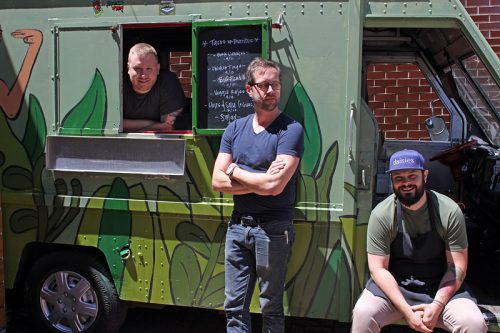
Dan Salls, Jay Schroeder and Ross Henke
Now Quiote itself is over a year old, a success and old enough to be taking stock of where it is and how it needs to evolve. Some things have worked—dinner has been met with general praise and steady bookings, and Ross Henke, a friend of Salls’ from when they worked together on another Mexican food project, has been promoted to full chef. Some have evolved—Quiote’s downstairs mescal bar helped mark the beginning of a mescal bar trend in Logan Square, when it and Mezcaleria Las Flores opened around the same time. Now Mezcaleria Las Flores is gone, and the mescal expert and Bayless vet behind it, Jay Schroeder, runs Quiote’s bar, which finally has a name of its own—Todos Santos.
And some things just didn’t work out at all—the idea of Quiote being an all-day cafe, with coffee and Mexican pastries in the morning and tacos at lunch, never took off in this neighborhood. (The old Salsa Truck is now parked on the patio and serves tacos and burritos to the bar at night.) I sat down with Salls, Henke and Schroeder to talk about how they’ve evolved Quiote since it opened, much of which has involved loosening it up, becoming more accessible while still taking Mexican food and Mexican spirits culture seriously and with respect.
1. Quiote
DAN SALLS: What I wanted to get a dialogue going about was, we’re a place that we had these ideas for, and we’ve realized a lot of them. But I turned around and, Ross had taken the kitchen to a certain place, and Jay had taken the beverage program to another place. And so Quiote is what we set out for it to be, and it’s also something other than what we had set out to be. It’s no longer, it has to be this certain way of doing Mexican food and this certain way of serving mescal.
I think in the beginning, I was scared of stepping away from very literal interpretations of Mexican food. I had this chip on my shoulder that it had to be this pristine iteration of Mexican food. And Ross has flipped that on its head.
ROSS HENKE: When we started, Dan was kind of the reason for the Mexican food, but although I love it, I wasn’t super practiced in it. I love the flavors, I love doing research on any food that I’m about to work with, but to call it authentic regional, Oaxacan food… was wrong. Because the food down there is incredible, and we weren’t doing that. We’re inspired by it, but we’re in Chicago, we’re landlocked and have five lakes around us, we by no means could do true Veracruz, true Puerto Escondido cuisine.
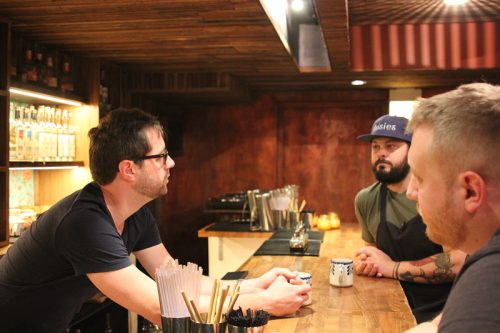
We took our midwestern ideas and techniques, and played them with the flavors and styles of Mexican food. We’re doing carnitas right now, but it’s turned into more of, like, a French pavé. We’re brining it, confiting it, pressing it with the pork skin holding it together, and it’s ladled over with an acidic salsa verde that we dropped super-hot fried Japanese eggplant into, which is a Japanese technique. But you eat it all together on a tortilla.
When I took it over, I said, let’s get the best ingredients we can use, let’s pay homage to the cuisine that we call ourselves, and let’s do something that people aren’t doing. There’s different ways of doing Mexican food in America. When people ask what cuisine it is, it’s Mexican-inspired for sure, but it’s really New American or midwestern-inspired food.
We evolved it into what we like to eat in America with Mexican ingredients. I don’t think a smoked whitefish salad with serrano cucumbers is dumbing it down.
Another one that just came on is a smoked whitefish from Lake Superior. I think that’s the epitome of midwestern fish, right? So we brine that, smoke it, we toss it in a serrano cucumber and avocado Green Goddess aguachile, it’s creamy like a Green Goddess from the avocado but acidic like an aguachile, we toss more fresh avocado with it and then we add Nichols turnips that are just super, super delicious right now, and we turn them into what you’d expect escabeche to taste like right now—like carrot, japaleño, onion. You close your eyes and it smells like an aguachile from Mexico, but it’s very midwestern. We’re using bush basil—you’re not going to find basil in Mexico, but it works in that dish.
SALLS: The guests are really, pun intended, eating up where Ross is taking it, and I think it’s positive reinforcement that we want to keep pushing it in this direction. It’s realigned our goals.
FOODITOR: Which are what?
SALLS: Well, there are the basic ones of stay open, have guests come in every day. When we opened we were an all-day cafe, and that turned out to be more work than it was worth.
HENKE: And it turns out that’s not what this restaurant wanted to be. Dan’s wife Dana says, restaurants have ears. Well, I think restaurants have souls, before you even kind of jump into them. And I think it forced us into certain things, with the basement and the back patio.
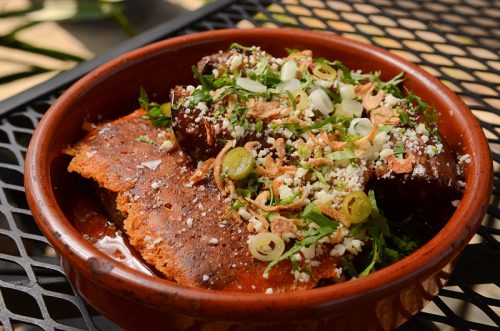 Jay Schroeder
Jay Schroeder Carnitas with salsa verde, Japanese eggplant
Okay, but some could hear what you’re saying as “We started as a very authentic Mexican restaurant, and it didn’t work, so we dumbed it down to make it more American.”
HENKE: Well… I don’t think we dumbed it down to make it American. We evolved it into what we like to eat in America with Mexican ingredients. I don’t think a smoked whitefish salad with serrano cucumbers is dumbing it down.
JAY SCHROEDER: I think you have to look at where you are. Look at Peru, and look at Chinese food in Peru, which is its own thing because of where they are and the ingredients that they have. It’s one of the things that to me really pushes cuisine forward, and it’s something that we have the opportunity to do here.
SALLS: And it’s not like it didn’t sell. We were busy last year. One admitted failure—the all-day cafe.
HENKE: The one thing that didn’t work was, just tacos!
SALLS: And as far as dumbing it down, the food is on a level that I could never have imagined. If anything the food is becoming more refined, there’s more technique going on.
HENKE: I think we opened with a safe menu—
SALLS: The food’s wild now. And the guests are continuing to come in, so to me, I see it as manifest destiny.
Well, if we’re doing a post-mortem on the first year, let’s talk about the part that died—the all day cafe and the lunchtime taco menu.
HENKE: We took the cafe and flipped it on its head—people do want those things from us, they just want them at night. They’re going to go out for lunch tacos anyway, but I think we were silly to think that we could gain that business.
But serving delicious tacos and burritos downstairs at night is just smart. And they are delicious frickin’ burritos—it’s the same pavé pork from Slagel Farms or Catalpa Grove that we serve upstairs. I mean, what food trucks are serving Catalpa Grove pork with hand-pressed tortillas?
SCHROEDER: The cuisine evolution has been really interesting because we do have the resource of the taco truck, which we’ve absorbed into Todos Santos. It has given us an outlet for just really simple, straightforward, soul-satisfying food. It fills a really pressing need for us in the basement, because people are there to drink, people are there for the cocktails—
HENKE: You get a couple of Jay’s cocktails in you, you want something.
What’s the interplay between the kitchen and the bar downstairs at this point, on menus or ingredients or whatever?
HENKE: Since Jay’s come on, we really grew together as a produce force. Jay would be like, how many pounds of melon can you get me? And I’d say, I can get you 40 cases by tomorrow, if you need them. I think the conversation about produce keeps us connected. What we use upstairs we use downstairs, so we actually use Mick Klug strawberries in your drink downstairs, we use them on your salad upstairs.
SCHROEDER: That’s something that’s in my back pocket from my time at Bayless, working with farmers. The cocktail program has been an entire sea change, and it’s one of the things that has really excited our staff.
HENKE: He’s taught me interesting flavor profiles. Like I would never put tarragon and cascabel chiles together, but I walked downstairs while he was making syrup and it was like, holy shit that’s good.

How has the staff reacted as the restaurant has evolved over the last year?
SALLS: We don’t have a bunch of older, been-there-done-that-going-through-the-motions people here—the three of us are probably three of the five oldest people here. We’ve tried to bring on younger people who are hungry and want to learn new things as they come along, and that’s a huge part of the culture.
We made it a year. This restaurant’s got legs. So how do you then start to think about creating a legacy? How do you create something, in a city where there’s a million restaurants open, and more openings every month and just as many closing, that stays relevant? Especially on a block that’s about to get crazy? We’ve got three Mexican restaurants within a mile on California, the Good Fortune guys are coming in and they’re going to make a big statement.
Part of the model is definitely Lula Cafe. We’re not them, obviously, we don’t do 600 covers at brunch, but that’s the question I’m asking myself every day, how do you create longevity, how do you stay relevant like they have to Logan Square? And it’s by growing the talent that you have and sometimes have had from the very beginning, by hiring weirdos like this guy [points at Jay Schroeder], just by having it be a super fun neighborhood restaurant. So that’s the question, how do you balance neighborhood with destination food, and a destination spirits program?
HENKE: We got the Bib Gourmand, I think that was one goal. I thought that was very achievable because we do the right guideline of food for it. We are a place where you can bring your parents for your birthday on a Tuesday—no wait, we’re closed on Tuesday, Wednesday—but also a place you bring a first date, a place you come to from out of town. We’ve evolved into a different view of people’s expectations. I mean, people came here from Belgium the other day. We had the editor of Cosmo Germany come in for dinner by himself the other day.
So if you’re in the midst of this evolution, what do you see as next?
SALLS: The next stage is letting these two keep doing what they’re doing. Before, it was throw as many things at the wall as we could and see what sticks. And there’s a few things that stuck really well. The biggest part for me is to continue to move forward, through tweaks to the menu, and consistency. Dana, one of the first things she ever said to me about the restaurant biz, and she’s worked at Alinea and Noma and all these places, is that it’s not who can create the most outrageous food and flavors, it’s who can do it day in and day out.
So there’s definitely a focus on consistency, but I think the biggest thing is to listen to our guests, and then grow it through programming—we’ve got the Burrito Battles [competitions with guest chefs for charity], we’re doing as many charitable things as possible, but not every single thing, we’re staying focused. We’ve got a garden on the rooftop, we’re growing things, we have epazote and other Mexican ingredients growing up there, and we have some beehives. I think the biggest impact is the bees, we’re working with a local beekeeper and he’s super stoked, because I guess Logan Boulevard is like a beekeeper’s dream. Logan Square honey, it’s like the epitome of hipster honey.
HENKE: Hipster bees!
I liked their early indie honeys.
HENKE: The later stuff is too sellout, man.
SALLS: But yeah, a lot of it is just staying relevant, by bringing guests in for as many different kinds of experiences as we can. Let’s try new things, let’s bring it every day, and how do you set yourself up for the future? A lot of those questions are unanswered yet, but you keep running with it, and keep your ear to the ground.
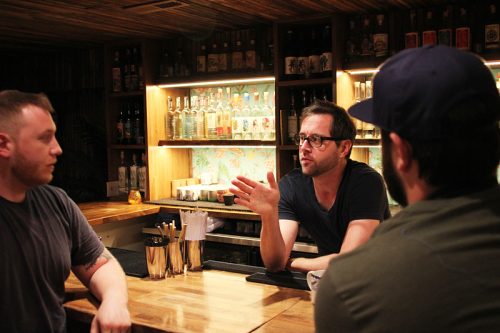
2. Todos Santos
We’ve talked about Quiote, let’s talk about how the mescal bar has evolved since you first opened.
SCHROEDER: I’m always thinking about how to contribute to beverage culture in the city—how to stay relevant, making sure we’re executing at a really high level. But at the same time, one thing that’s important to me is, when you come in to a restaurant and sit down and look at a menu, you can probably tell what 80% of those things are. You know what those ingredients are, you know the direction that the dish is going, it all makes perfect sense to you.
People come into a cocktail bar, and they are scared. Flip that 80 on its head, and that’s 80% of the stuff that’s in it they don’t know. Great, it’s got lemon in it, thanks. The ingredients, that’s what’s fun for us cocktail folks, that’s our language and our currency. But all of our drinks have at least two or three things in them that people are familiar with. I’m not trying to change the game—but I am trying to put out the highest level, most intricate, meticulous drinks that I can. But it’s going to be a lot easier for the consumer to understand if it’s got pineapple in it, than if it’s got Gum Arabic.
It lets us put up drinks that can be made quickly and that aren’t boring and unfun, and aren’t fussy. But there’s layers there, too.
The original intent was trying to mold all these experiences, upstairs and down, into one concept. And the downstairs is just different. I’ve had the pleasure and the curse of doing multiple dual concepts in the past, and they have to be as close together as two sides of a sheet of paper—but they have to be separate things. And now it’s about bringing the two concepts together and being able to work creatively on different projects.
HENKE: We used to be very loose about it—oh, you want that cocktail up here? No problem. Now, you want that cocktail experience, sorry, go downstairs. The cocktail experience upstairs is very approachable—if you want to get a little nerdy, you can, but people for dinner are playing it pretty safe. “I want a margarita and the bone marrow.”
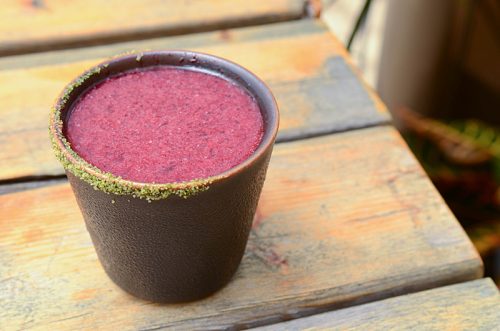 Jay Schroeder
Jay Schroeder Yoshi City: Mayalen Machetazo cupreata, Klug Farm blackberries, Lustau brandy de Jerez, royal Combier, basil, salt, lemon juice
SCHROEDER: Two words: food friendly. I went out the other night and had a cocktail that had like nine ingredients. And yes, all nine ingredients are there, but the volume on them is turned down to like a one or a two. Upstairs, you have to dial it down for food, because I don’t know if you’re going to order the avocado salad or the chicken in mole.
Downstairs it’s the opposite, because we have foods that are sort of the universal palate, tacos and burritos, so the cocktails are meant to be more flavor-intense.
Quiote originally opened with a mescal bar right as mescal was becoming trendy and to a certain extent, ubiquitous on the cocktail scene. How do you deal with that?
SCHROEDER: We just double down on being nerdy, but fun-nerdy. We have this really cool accessible cocktail program that brings people into the idea of drinking mescal. But there are people who come in, and they are scared of the idea of drinking mescal. So we use a cocktail as a tool to open that door, and then follow it with just absurd levels of knowledge.
I had a brand rep come in the other day, and do a class for our full house bar staff. She does this four times a week, and she broke into the middle of things and said, “This is the highest level class I’ve ever done.”
What does that mean—to be high level?
SCHROEDER: We just constantly have conversations. And I’m not one to shy away from the details behind these things—if I taste something and I realize there’s a point in the process that has created these flavors or texture, I tell it to the whole staff and we sit there and talk about it. I go “Stop. Taste this. Let’s try this and talk about it.” Not trying to shy away from that stuff and really trying to learn everything we can is what separates us.
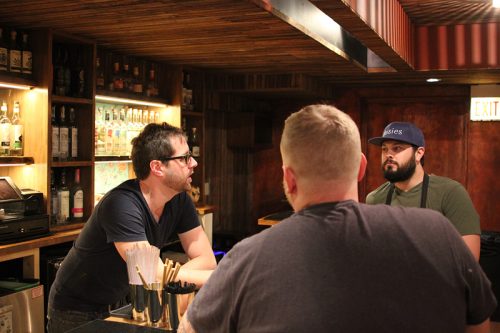
HENKE: Listening to some people talk about spirits, you just think, “You’re just using buzzwords —I could say that.” With Jay, it’s not bullshit. It’s a man dedicated to a thing for his life.
SCHROEDER: The thing that we have, also, is that our clientele comes in and either wants to have a good time, or wants to sit down and nerd out with us and talk to us and taste things. We had a guest come in the other night and gravitate toward stuff from Durango and from Chihuahua. So we could have a really good conversation about the gradient of production culture in those two areas. People say you don’t make sotol in Sonora. You absolutely do, there are sotol producers in Sonora next to Chihuahua. And he’s getting this really cool comprehensive experience that he didn’t even know he was getting.
We get to have those experiences with our guests, and we get to learn even more.
You’re screwing over your producer or you’re doing things that water down the hard work of the people who make mescal—I’m not going to buy that.
SALLS: In the beginning it was very tasting room, it was very austere. Now you can eat a burrito or some tacos and have a Tecate, or you can learn something. And it’s not Jay—I think all of our bar staff is like that.
HENKE: I think we opened with a bar staff that was half here to get nerdy, and half just here to make money. Our bar will make you money, but you’re not here to make Parsons money, Sportsman’s money. The people now, I think they’ve really bought into what Jay’s selling.
SCHROEDER: I got my soldiers on the front lines. I’ve got guests who’ll come in and I’ll start serving them and they’ll be like, uh, can Guillermo come over and talk to us? Okay, no problem if you don’t want me…
HENKE: Guillermo’s the definition of this place. He wants to party, but he can also dive into a book and come up super nerdy.
So with all kinds of places trying to have the newest, hottest mescals, how do you select your list and ensure that it’s the quality you want to offer?
SCHROEDER: One of my main goals is to strengthen our relationships with our producers. The amount of money in Chicago that goes into bars and restaurants—a tiny drop in that bucket has the ability to do so much for the people on the ground, the actual producing families of agave spirits all over Mexico. It’s one of my goals to see who we can be working with. People who have a product already come to me and ask for help getting into the market. If it’s something worthwhile, I’ll try to shepherd them, and if not, I tell them what I think is good about it, what I think is not so good, and then kind of send them on their way.
I’m working really hard to represent the people who make the stuff—
HENKE: That’s the whole concept, only mescal made by good people and brought here by good people. I think that’s the idea behind all the ingredients we bring in, we want to know who’s bringing it in and make sure they aren’t screwing over the people who work the hardest.
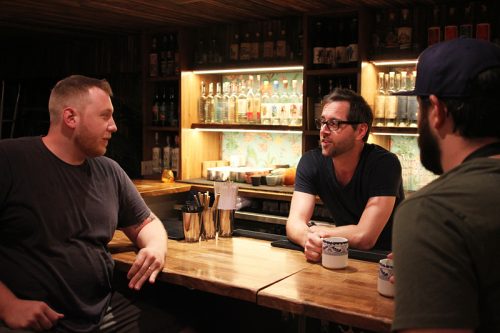
SCHROEDER: I’m using this as a lever for social change as much as I can. And if I find out that someone’s doing something sketchy, or not being transparent, or maybe there’s a bad business relationship with the end producers, who maybe get the shortest end of the stick of all, I’ll kick somebody out of the house in a minute. I’ll make a stink about it. I talk to all the other people in the greater Chicago agave communities, and I put pressure on people to do the right thing. You’re screwing over your producer or you’re buying it from multiple places and putting them all together—things that water down the hard work of the people who make mescal—I’m not going to buy that.
A couple of weeks ago I tested the alcohol content of a bottle, and it was 4% off what it said on the label. And we kicked it out of the house. What probably was likely was, the person that was selling it to them was stepping on it, and cutting it with water to make their product go further, and then shipping it up, and once it’s past federal label approval, there’s no more testing.
But we test it. We will go to your palenque, and we will find you, and the thing that you’re not supposed to have, and confront you about it. And I do this not because I’m a hater, but because I genuinely care about this sphere of spirits being a bastion of quality. Rum is real sad; as delicious as it is, you can do anything you want to it and nobody cares. Tequila is real sad, you can flavor it, you can doctor it, you can sweeten it. This is a realm that is, as of yet, much less touched. And I want to fight for whatever the highest road we can achieve is.
Michael Gebert is el Jefe de Fooditor.
Latest
Join the Discussion
After you comment, click Post. If you're not already logged in you will be asked to log in or register with Disqus.





